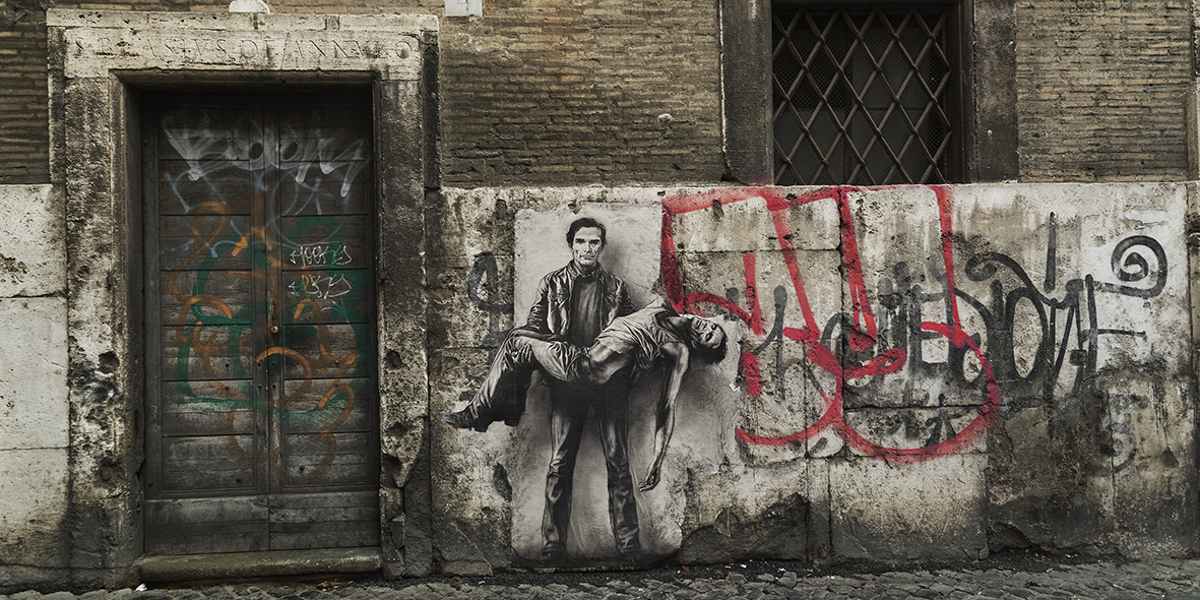
Ernest Pignon-Ernest – Pasolini, Rome, 2015 – Image via pignon-ernest.com
Whilst the United Kingdom and the United States street art scenes seem to be thoroughly studied and well investigated, modern art history has a somewhat surprising tendency to neglect the French street scene to a point it falls second to the aforementioned western locations. Theories about why this is so are varied and diverse, with the most common argument usually being the lack of controversy or explosiveness the French scene allegedly suffered from during the course of the last half a century. As is a common occurrence, the majority of people relate street art with vandalism and thuggish lifestyles – and in all honesty, often with good reasons, as the United Kingdom and the United States street art scenes have been heavily adopted by gang members and the likes of other criminals, especially in their early stages. The lack of such a spotlight was definitely a factor why other scenes had more headline materials and coverage as urban art was being developed.
Today, the French scene still persistently chooses to take its own paths despite the roads which host other scenes of the world. Over the course of the last few decades, most contemporary street artists tended to slide into commercial muralism and similar urban artworks that attract the most attention, whilst French street art stayed consistent and true to its roots by not adopting such norms. Whilst this came at the price of popularity, French urban interventionists ultimately proved that avoiding commercialism and focusing on unique urban installations is the right way to preserve the identity of true street art. This resulted in an all too familiar outcome. As the case was numerous times before street art was even a thing, France is the one that dictates the elite norms, the one who aspires to be not only distinct but richer and numerous steps ahead of any contemporary competitor. French street art is so unlike any other urban expression that it deserves to have a special category of its own – it’s so genuine to its roots that it’s totally unlike any other scene world has to offer at this point.
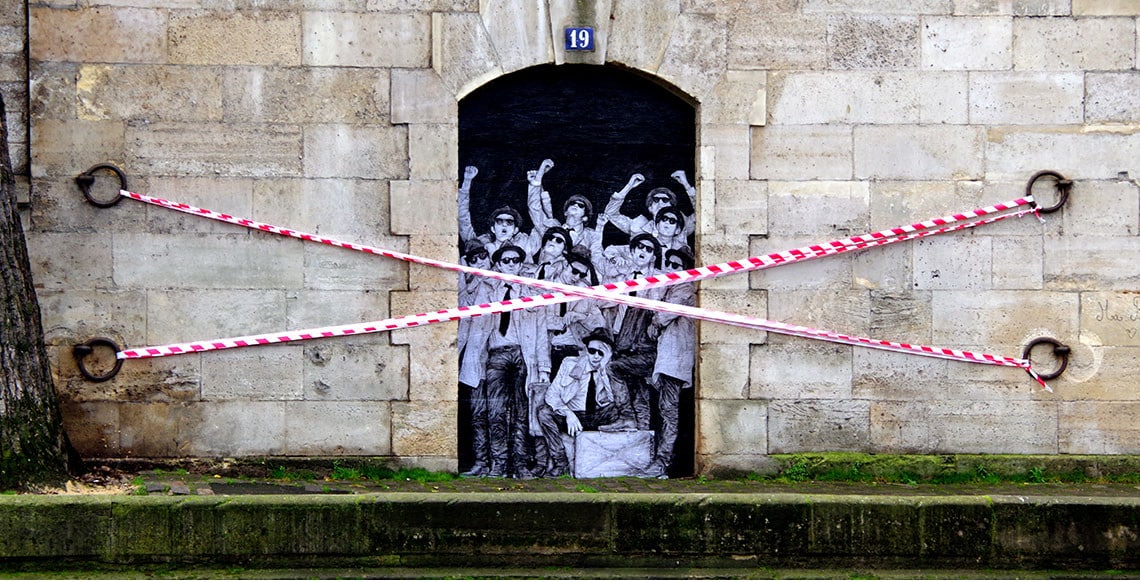
Levalet – Street Art Do Not Cross – Image courtesy of the artist
Situationism – History and Definition
In order for one to truly grasp what French street art is all about, a necessity is understanding the concept of Situationism that is so deeply branded into the identity of this country’s urban expression. This will provide us not only with a historical beginning but also with the fundamental knowledge of principles that drove early street artists. The Situationist International, often referred to simply as SI, was a highly regarded international organization from the 1950s, made up of social revolutionaries whose ranks were filled with avant-garde artists, intellectuals and political theorists. The members of what will eventually grow into the movement of Situationism were heavily influenced by the concepts of Dada, Surrealism and Lettrism, with the letter being the crucial one. The reason behind that is the fact the post-war Lettrist International was a direct forerunner of the group which founded the magazine Situationiste Internationale during the year of 1957 – the time art history recognizes the birth of Situationism. Logically, much of the ideas behind the Lettrist International were channeled into the new group. The primary goal of The Situationist International was to avoid what they called the suppression of art, transforming that aim into the eventual Situationism definition. The followers of this movement desired to supersede the categorization of art and culture as separate activities – a practice which was rather popular in conventional artistic circles. Early situationist art concepts aimed at incorporating artistic expression into everyday circumstances, transforming it into a natural and organic segment of our existence. At first, the movement was mainly made up of individuals who created art and not too many of those who wrote about it, allowing the likes of Asger Jorn to be the most prominent speaker and writer of the group. Eventually, however, Situationist International attracted newcomers such as Guy Debord who emerged as the most important figure of the movement. By 1962, the Situationists became more radical in their goals and started spreading their critique to all aspects of capitalist society.
As the members of The Situationist International started to become increasingly famous, more and more of their efforts were focused on political aspects of European societies. Towards the movements end which occurred in 1972, Situationists were politicly stretched between the Marxist ideas and anarchy, although the communistic concepts seemed to be the member’s regular preference. Somewhere along the line, political conditions became more important than any art form and this was effectively the end of the movement as we know it. Members sailed away in different directions and most concentrated on other fields after the year of 1972. When all was said and done, Situationist ideas enabled a plethora of modern moments to occur. For instance, their theories exerted a strong influence on the language of the punk rock phenomenon of the 1970s and some avant-garde threads such as Neoism were strongly based on Situationism. However, what interest us the most on this particular occasion is the impact Situationism had on local street art. First of all, one of the main slogans behind both the magazine and the movement was Beauty is in the street, so this is naturally the first indication on common grounds Situationist International and urban art share. The fundamental norm which served as a primary motto of the Situationists was the aforementioned blending of art with everyday surroundings, a feature which became a crucial characteristic of French street art. Unlike graffiti that were popular around the world, French artists did not desire to merely decorate or vandalize their surroundings – they desired to transform it, to insert a piece that shall serve as a pivotal segment of a location. This drove early French street artists to become fond of what may be better described as urban art installations than graffiti, adjusting the focal point of an entire genre in a much more situationist direction.

Jacques Villeglé – Boulevard Saint Martin, 1959 – Image via villegle.fr
Incorporating Situationism into Early French Street Art
Roots of French Street Art as we know it today can be traced to the early 1960s, more than a decade before graffiti started to appear in the United States. One of the biggest names in the early French scene was Jacques Villegle, a mixed-media artist that designed his unique variation of the collage technique in the aftermath of World War II. He spent his entire creative career working exclusively in this style which he called decollage. This method was derived from a concept which is the perfect opposite of collage technique – instead of an illustration being formed from the portions of different pictures, it is created by splitting, tearing away or otherwise destroying segments of images that have been stacked upon each other. It should be mentioned that many specialists insist that this particular method is not genuine decollage, but instead something they call the lacerated poster technique, although the only true difference between the two is that the latter utilizes posters instead of newspaper pieces or other kinds of paper clippings. Putting that aside, Jacques Villegle is important to our topic because of his practice to transform the torn advertising posters into striking compositions which he would return to the same urban locations where he found the original materials in the first place. This effectively makes Jacques the first prototype of a genuine street artist and no story concerning French urban expression can be valid nor complete without mentioning his name. By presenting the public with his street pieces, Villegle desired to communicate a message to society – a concept so ahead of its time, responsible for bestowing a stellar reputation to Jacques thanks to which he is widely regarded for paving the road for the modern street art. He would discuss various topics with his pieces, covering everything from humor to eroticism, presenting clever satire as well as strong political statements. His art was directly bound to the street, to the grounded life, the anonymous, the marginal. Two other facts should also be noted when it comes to Jacques Villegle’s art. The first one is that he was the first truly original artist after the horrors of the World War II, emerging in a time when many honestly believed that artistic expression died after all the destruction that occurred around Europe, which makes his art that much more important. The second fact is a bit more crucial to our subject at hand – Villegle started creating art before Situationism came to be, although many concepts of it were very well established. This means that Jacques was not only a practitioner of Situationism but also one of the artists around whom The Situationist International organized their theories.
Since we are on the topic of poster usage within the field of public art, naming another artist is a must. This is, of course, Daniel Buren, a man who put up alternating stripes of paper over billboards and advertisements around Paris during the late 1960s. He developed his own form of detournement, which meant taking something that has a common use or meaning and reusing it for a different manner without official approval. His public artwork was hung on advertisements and in metro stations. Buren is mostly famed for his site-specific installation Affichages sauvages, created primarily in the Parisian metro during the year of 1967. Usage of posters allowed for quick and unlimited reproduction and quick execution on the spot, which made them one of the preferred techniques in street art due to often confrontations with authorities. Ultimately, Daniel Buren as well proved that art does not need a gallery or museum to exist and that its existence can be boundless – in other words, he demonstrated that art can freely exist as an un-commodified and unreciprocated event that exists anywhere. Both Jacques Villegle and Daniel Buren had a massive impact on the future of French street art, influencing many artists who would be defining modern norms in the future, such as SP38 and OX.
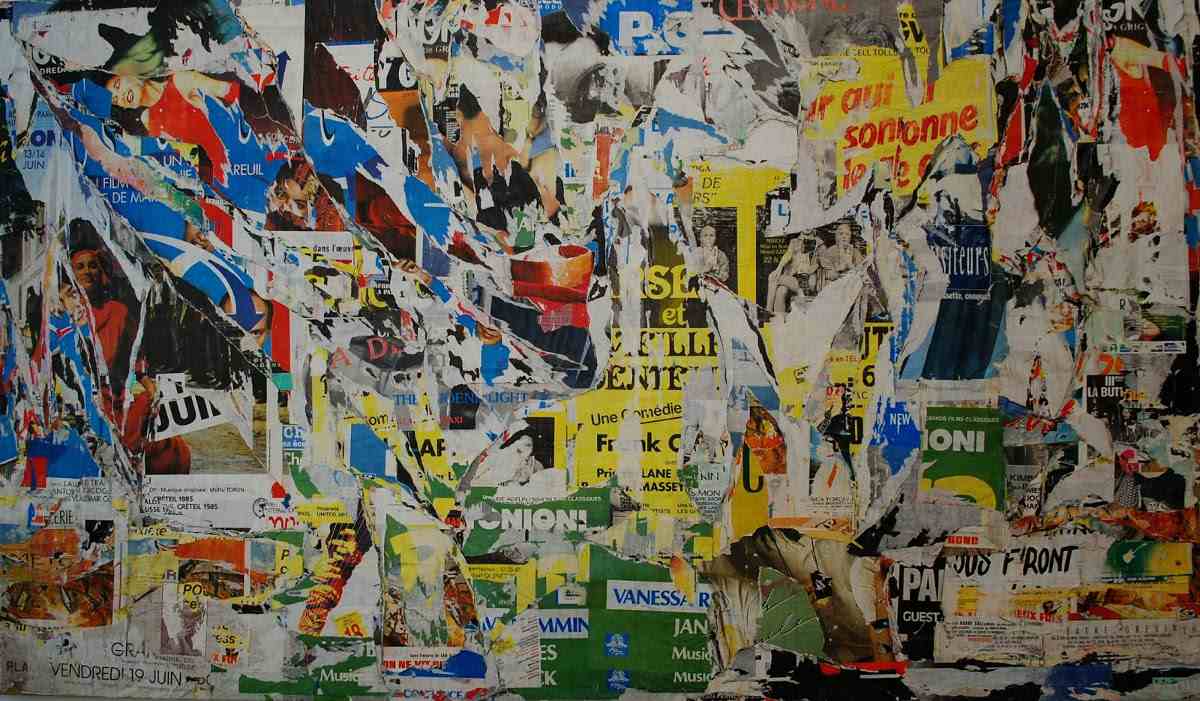
Jacques Villegle – Rennes-Montparnasse – Image via villegle.fr
Developing French Graffiti
Whilst the New York graffiti-filled scene gained international attention and headlines due to the rebellious and borderline criminal nature, the 1970s marked the beginnings of modern French street art which tended to be much more poetic and adapted to circumstances. Unlike its western counterparts, the French take on urban art could much more precisely be called urban installations and they were nothing like the usual tags commonly found in the United States. French pieces had a deeper purpose, a fundamental reasoning why the artwork is placed at a particular location – obviously a heavy impact of Situationism. Furthermore, French street art showed an early tendency to make urban expression into a logical and worthy continuum of general French art history. Stencils, posters and murals appeared around the French cities, announcing a novel understanding of public art whilst simultaneously introducing various techniques to the streets, rarely counting on the preferred New-Yorkian aerosol. French street art was growing on the country’s artistic heritage of which it was extremely aware, incorporating poster wheat pasting, stenciling and other innovative expressions that did not revolve around simply lettering a location and marking your presence. Additionally, French aesthetics did not choose the same path as the western scenes as the pure visuals were not the primary goal of early French street art – in as sense, they were much closer to avant-garde movements and their theories than their rival urban scenes around Europe and in the United States.
Just as the case with more traditional moments in art history such as Neoclassicism or Impressionism, it’s hard to pinpoint the exact time when street art started transpiring in a state we recognize it today. However, many historians concur that genuine street art in France can be traced to the year of 1971, to the expansive ruins of Les Halles. This green market in the center of Paris was demolished that year in order to make room for a modern metro station and a shopping center. This is when artist Gérard Zlotykamien entered the shattered site and covered the walls with silhouettes of reclining human figures, evoking the 1945 nuclear destruction of Hiroshima and the haunting way unfortunate individuals who found themselves present in this Japanese city met their end. Zlotykamien’s creative weapon of choice was the spray can and his pieces marked all the characteristics of French street art – protesting against current injustices, careful choosing of a location and a direct, deep message conveying. It was not a part of a series nor a tag, but instead a clever and direct urban installation. Simultaneously whilst Gérard Zlotykamien was creating his pieces, another artist was working hard on his own paintings within the field of street art. This man is, of course, the legendary Ernest Pignon-Ernest, a situationist and a member of the Fluxus. His wheat pastes only furthered what French early street art was all about – his pieces are infused with both politics and poetry, emotions and spirits of those in need of remembrance. Amongst his numerous public installations, and that’s what his pieces unquestionably were, the one that really stands out as a great example of honoring the notions of French street art was the silkscreen portraits of Arthur Rimbaud, spread around the romantic poet’s favorite locales in The City of Light. Ernest Pignon-Ernest stayed active to this day, continuously demanding attention and putting it on those in need and on the margin, tirelessly creating his ethereal, excruciatingly spatial installations. Logically, he also had a massive impact on younger artists, among whom Levalet’s name truly stands out.
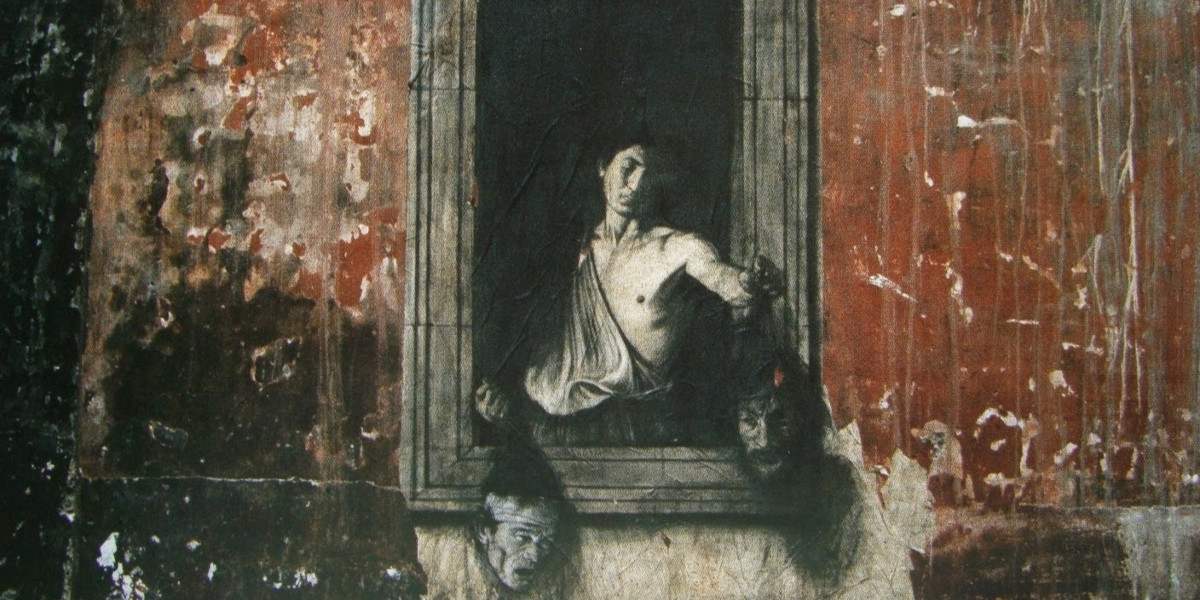
Ernest Pignon-Ernest – David et Goliath, 1988 – Image via pignon-ernest.com
The Magic of Stencils
As was said before, French street art was historically and socially very conscious from its beginnings. It rapidly incorporated many different mediums, where those which were already used to communicate propaganda messages were the easiest to assimilate and turn on themselves. Arguably one of the top three most popular, common and famous techniques in street art to date, stencils were one of the methods quickly incorporated by urban interventionists. Once the prime medium of Italian fascist dictator Mussolini’s hordes and American soldiers fighting against the nazi machine, stencils’ relatively hidden creative potential was introduced by a particular French artist who even Banksy calls the uncrowned king of the medium. This is Blek le Rat, an artist who started dispersing his life-size stencils around Paris in the early 1980s. Interestingly, Blek le Rat never hid the fact he was inspired by the fascist stencils, which may come as a surprise to many who believe one should be ashamed of such influences. This is far from the truth, however, as Blek le Rat himself proved – the best way of utterly destroying evil is to transform it into a bearer of a message of freedom, not ignoring its existence. In his early life, Blek desired to create something new that can be described as completely his own, something that would distinguish him from the rest of the early urban painters in France and establish him as a leading artist of the street. We should really stress yet again that street art back then was highly illegal and the utilization of pre-stenciled posters and images allowed the application of paint to be a lot speedier, which proved quite useful. Blek le Rat was an author of both large murals and smaller portraits, always depicting rats alongside his compositions as these animals were his recognizable trademark. Although his earliest pieces were rather experimental and lighter in the motif department, Blek le Rat’s mature pieces were perfect examples of how French street art is focused on questions that regard politics, social circumstances and environmental problems. This artist is also one of the most referenced artists by other artists as mostly all of the younger stencil makers owe their techniques to Blek le Rat.
Opening up with Blek le Rat’s contributions to the medium, the 80s chapter of street art history in France proved to be the happiest time for this kind of art. It was during this period that urban expression was noticed by officials, although it was still regarded as borderline preposterous in terms of an art form. One of the main representatives of the French street art of the 80s is Jef Aerosol, an artist from Lille who is still creating today. Just as Blek le Rat, Jef Aerosol is also a stencil artist. His wonderfully executed artworks often portrayed celebrity figures from the pop culture history, but marginalized characters from the outskirts of society were his regular subjects as well. Just like Blek before him had a mark that made him instantly recognizable, all of Jef’s works are identifiable by a red arrow which is considered to be the artist’s emblem. They usually point to the key element that leads to a complete understanding of his compositions. The level of detail Aerosol was able to insert into his pieces is unrivaled to this day. Working in the same time frame as Jef Aerosol, Miss Tic was the pioneer of French street art among women. She was active during the mid-80s and predominantly focused on working class neighborhoods of 13th and 20th Parisian districts. Her stencils are rather rare, as she was not as active as her male colleagues, but her pin-up aesthetics followed by a textual message are a crucial aspect of one’s understanding of French street art – especially from a female perspective.
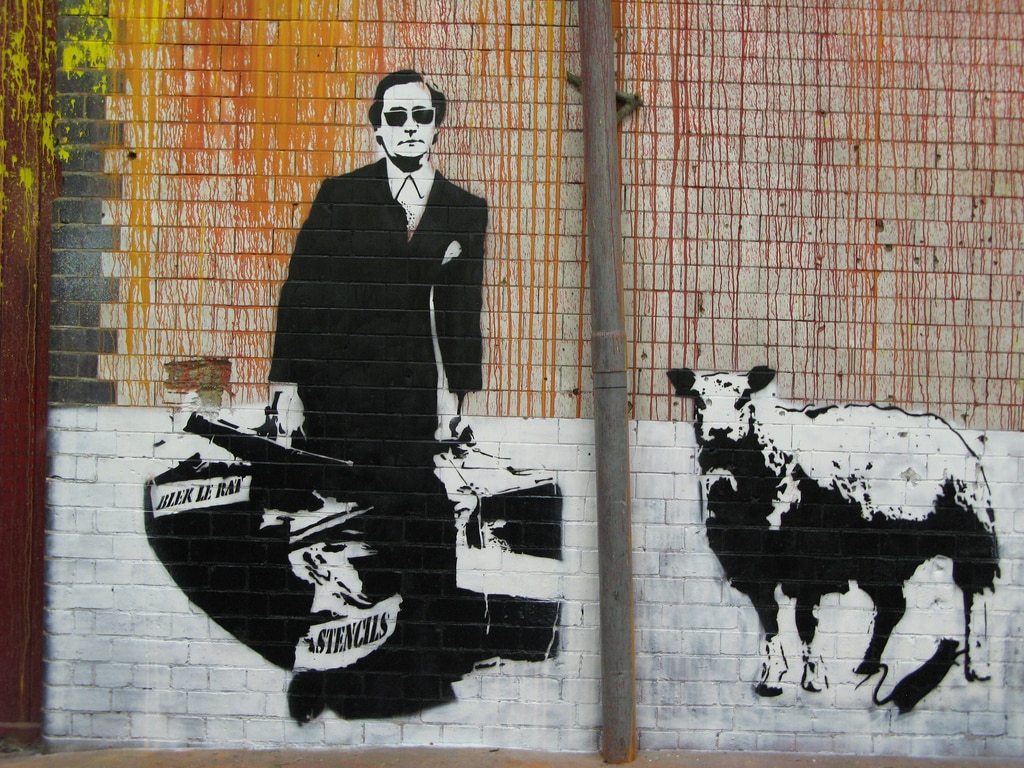
Blek le Rat – Autoportrait – Image via bleklerat.free.fr
Modern Circumstances
As is a rather natural occurrence in the world of art, throughout the 1990s, a new generation of street artists blossomed, armed with a completely new idea of what street art is and what it should be. This period, especially the early and mid-90s, were marked by an expensive effort from the government to clean up the pieces of urban art. This enraged many artists, but also the public as the members of society realized how connected and crucial urban artworks were to them. One of the better-known creatives whose works emerged during this period was Zevs, an artist famous for his characteristic logos which were incorporated into his pieces. He was also distinguishable for his very specific technique of liquifying the letters and signs, a method that surprisingly had a neat manner. Monsieur Chat is one of the 90s artists as well, having started to depict his signature yellow cats in 1993. Although he was not French himself, Monsieur Chat influenced many members of the Parisian scene due to his clever installation of the pieces spread across Paris.
The 2000s were marked by a sudden change in street art on a worldwide level. Official attitudes towards the urban expression began changing dramatically and large-scale murals, graffiti projects and street art organizations started popping up everywhere around Europe and The United States. Logically, Paris was one of those affected places and this marks a period which can be described as the end of street art’s previous state. Urban pieces began making their way into the heart of Paris legally, for the first time ever. Even some prestigious art spaces dedicated portions of their programs to street art, allowing contemporary artists to express their visions and styles. They treated graffiti and stencil makers like sculptors or oil painters, turning the entire game plan on its head. Suddenly, illegal was not in a street artist’s vocation description anymore and there was no more need for aspects such as speed or rebellion. Although many iconic aforementioned artists such as Ernest managed to evolve and adapt to the new requirements, this modern period was the time when many newcomers started building their reputation.
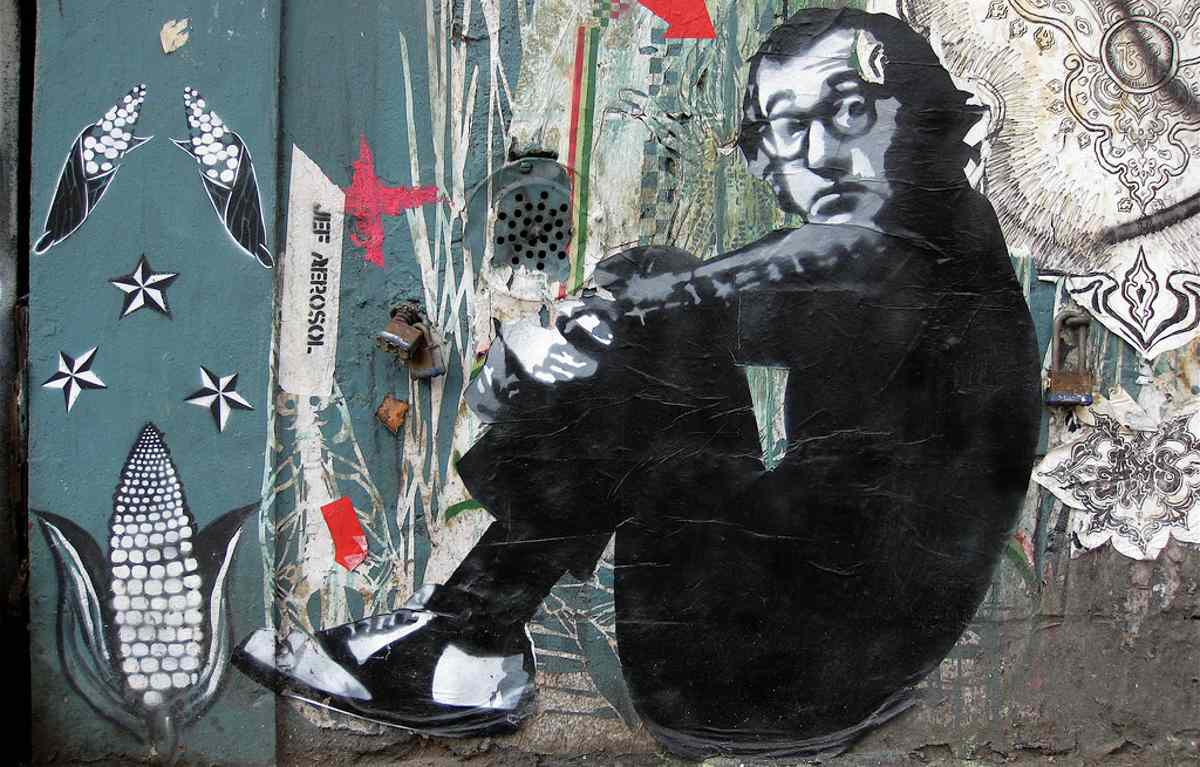
Jef Aerosol – Woody Allen – Image via jefaerosol.com
Contemporary Takes on Situationist Art
Just like it has always been, street art of France today is as diverse and varied as ever. There are many urban practitioners who investigate completely new grounds, such as the famous JR. However, there are many contemporary urban artists who work hard at proving the continuity of French street art, developing concepts of already well-established creative notions laid down by some of the aforementioned artists. In a sense, these are the artists who can be viewed as the tip of an ever-growing artistic spear, working on familiar ideas and laying grounds for future individuals who will be developing these concepts even further at one point. These artists can be understood as links of the same chain with the likes of Ernest and Blek le Rat, proving that the flow of French street art is still heading in the same direction despite many venturing off the said path.
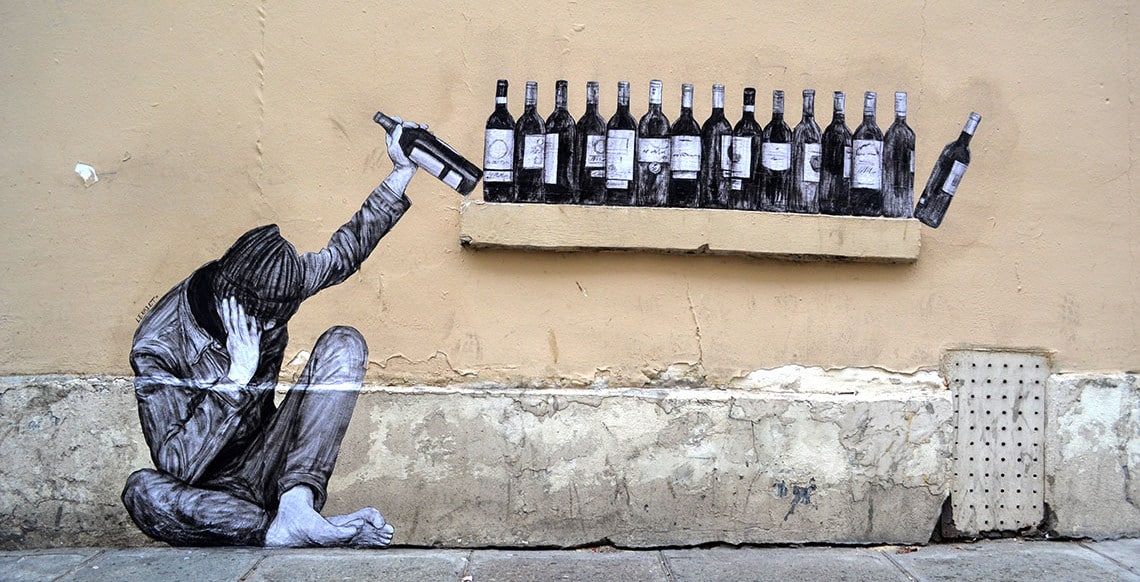
Levalet – Street Art Celle de Trop – Image courtesy of the artist
Levalet
As far as Ernest Pignon-Ernest’s spiritual successors go, there are not too many artists on that elite list. The name that seems to top that list more often than not is Charles Leval, much better known by his alias of Levalet. This Paris-based street artist became famous for his wheat pasted collages and imagery that references the classic street artworks of the 80s, all the while maintaining his old-school aesthetics that pays homage to the legend of Ernest Pignon-Ernest. Reasons behind his choice of paste-up as his primary medium was based on his desire to work with much more serious and challenging drawings than the case would be if he decided to operate with graffiti or stencils. Levalet also continues another aspect of the iconic artist’s work – just as Ernest Pignon-Ernest before him, Charles Leval maintains a special relationship between the piece and the location. The way Levalet takes advantage of Paris’ architecture combined with the fact his pieces are never a part of a series but rather a site-specific scene blend into a fact that this artist is a lot more like an installation author than a mere graffiti painter. In a sense, Levalet’s art is in a search for a sort of installations compatible with the streets in a way that makes the piece and location interact. Transforming his fantastic pieces into a fundamental part of Paris’ identity also extends Levalet’s work to links with the likes of Blek le Rat and similar artists who observed their work in this light. The way his paste-ups are able to totally integrate themselves into the urban landscape leaves the impression that they are pieces of a jigsaw that were simply missing until now – a fantastic feature that serves as a focal point of Charles’ career.
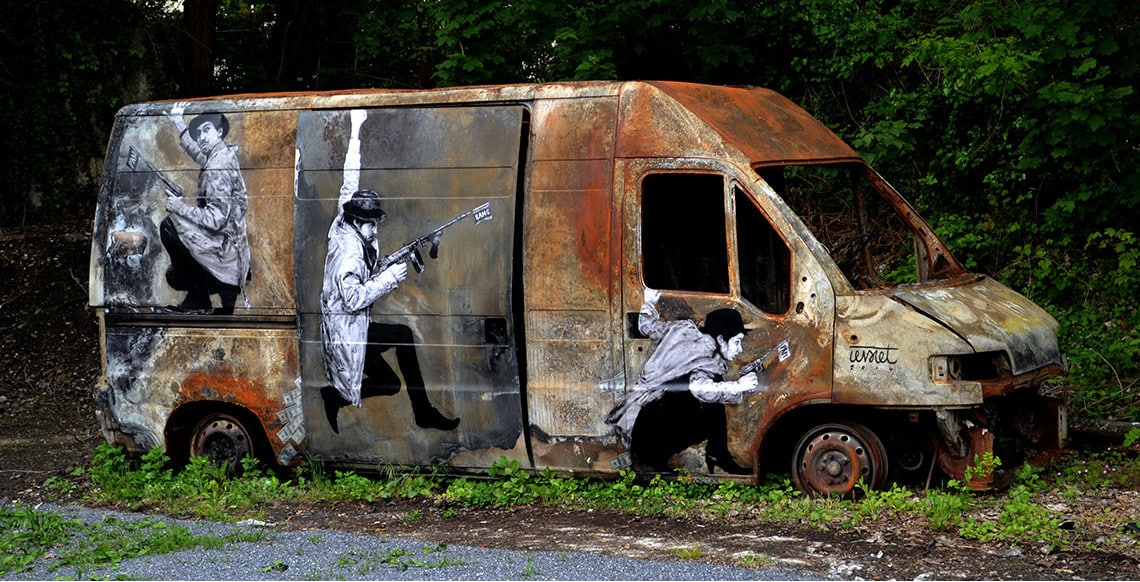
Levalet – Street Art Le feu de laction – Image courtesy of the artist
SP38
Although he is now based in Germany, the artist known as SP38 hails originally from France and therefore it’s no mistake to mention him within this article. Also inspired by the Buren’s takes on billboard advertisements and Villegle’s outdoors pieces, SP38 became famous for his incredible and unique posters which combine practices of silk-printing and traditional painting techniques, creatively enhanced by thought-provoking slogans which serve as his trademark. His statements are equally inspired by classical literature, current politics and many aspects of his personal life. SP38 honors Villegle’s art in another way and that is by working hard at his trademark typography. Just as the greatest pieces of French street art, SP38 often reflects current events with attempts to conduct a relevant dialogue with the city’s inhabitants – this practice is a perfect match with the ideas of The Situationist International. It also means that SP38’s artworks are also much better described as urban installations than graffiti or some other form of street art that functions through series. It should be noted that this French artist does not limit himself to just working in Germany – SP38’s pieces have found their way into many cities of many countries around Europe.

SP38 – Mural in Paris – Photo by Thierry Débonnaire
Madame
Sustaining the creative legacy of Jacques Villegle’s outdoors collage-based pieces well and alive, Madame (also known by the alias of Madame Moustache) is a French street artist whose artworks are not really comparable with any other work out there, whether it be Paris or any other location in the world. What makes Madame so different from everyone else is the fact she exclusively utilizes collages in her street works – a very rare material in this particular field of art and the exact choice that makes Moustache the closest thing Jacques Villegle has to a spiritual heir. This fundamentally uncombinable match-up between collage and the outdoor is what makes Madame’s work instantly recognizable – just as the case was with Jacques fifty years ago. Although Madame Moustache’s identity remains a well-hidden secret, her pieces are not too hard to find. She is responsible for covering urban surfaces with huge clippings from old newspapers and magazines, underlined by a strong note of retro aesthetics. This is another connection Madame has with previous iconic French street artists – she works hard to make sure her artworks seem as if they’ve been pulled straight out of magazines from the early 1960s. Madame Moustache mixes old materials such as paper, cardboard, engravings, drawings, pictures, fabric, metal and wood, all in order to communicate humorous statements that mostly concern issues such as gender identity and stereotypes. With goals of highlighting human traits such as kindness, sharing, solidarity and affection, Madame designed a comical universe populated by weird women, cats with fishlike features and housewives with bodies of macho sportsman. Just as Jef Aerosol and Blek le Rat, Madame leaves her own trademark under each pasted artwork – a black mustache. Another connection Madame has with the French past can be made through relating her with Miss Tic, as female artists within the field of street expression remained a rare occurrence to date.
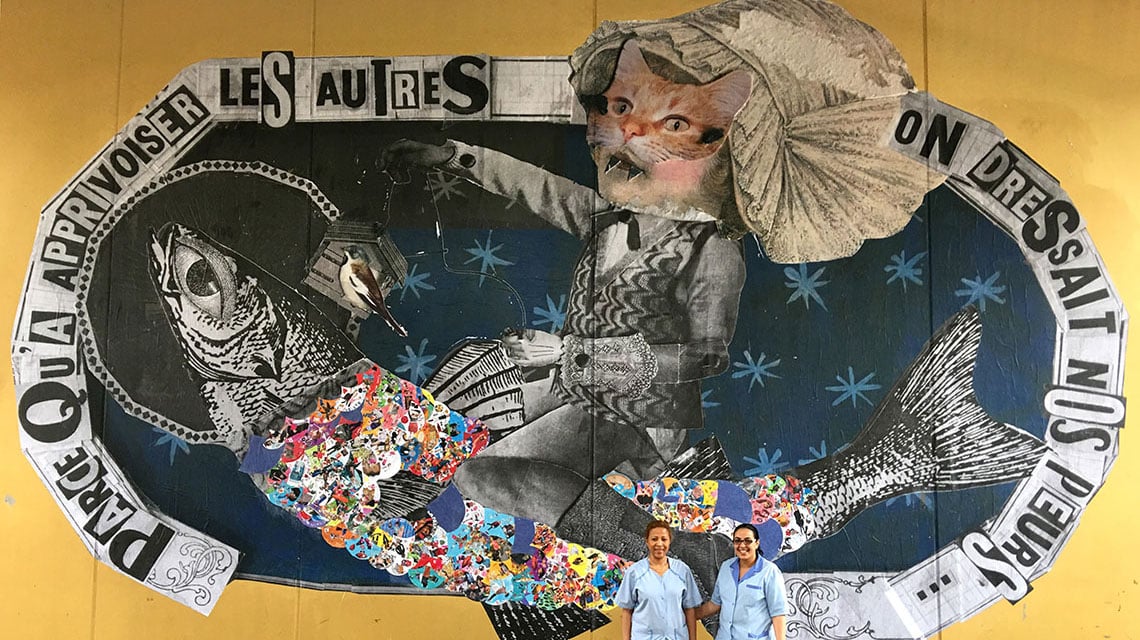
Madame – Untitled Piece in Paris – Image courtesy of the artist
OX
Heavily influenced by the way early street artists utilized billboard advertisements, French artist OX plays the role best described as a modern hijacker of billboards. Just as Daniel Buren had his way of manipulating ads that were bombarding Parisian society during the 1970s, OX uses both the tools and spaces that were originally designed to manipulate the wider masses. Armed with his paper cut-outs, rollers and glue, the artist turns advertisements into paste-up shelters of color. OX enjoys adding a strong note of humor to his incredibly simple pieces, underlined by a minimalistic tendency. This feature makes OX different from his spiritual predecessors as Buren’s projects such as Affichages sauvages were a bit more complicated in its visuals – in fact, OX actually prefers to call his works Affichages, honoring his influences. Just as the case is with Madame, Jacques Villegle’s outdoors collages had an enormous role to play in establishing OX’s practice – this French contemporary artist as well installs his pieces to the same locations advertisements were taken down in the first place. OX’s witty and minimalistic visual language can actually be traced to a time as early as the 1980s as he started to be active around the year of 1988. His vocabulary developed over the last two and a half decades before it became what it is today. The main change he took on over time was the simplification of his forms as OX was removing everything he found unimportant within his compositions, paying his respects to the avant-garde concepts of Minimalism.
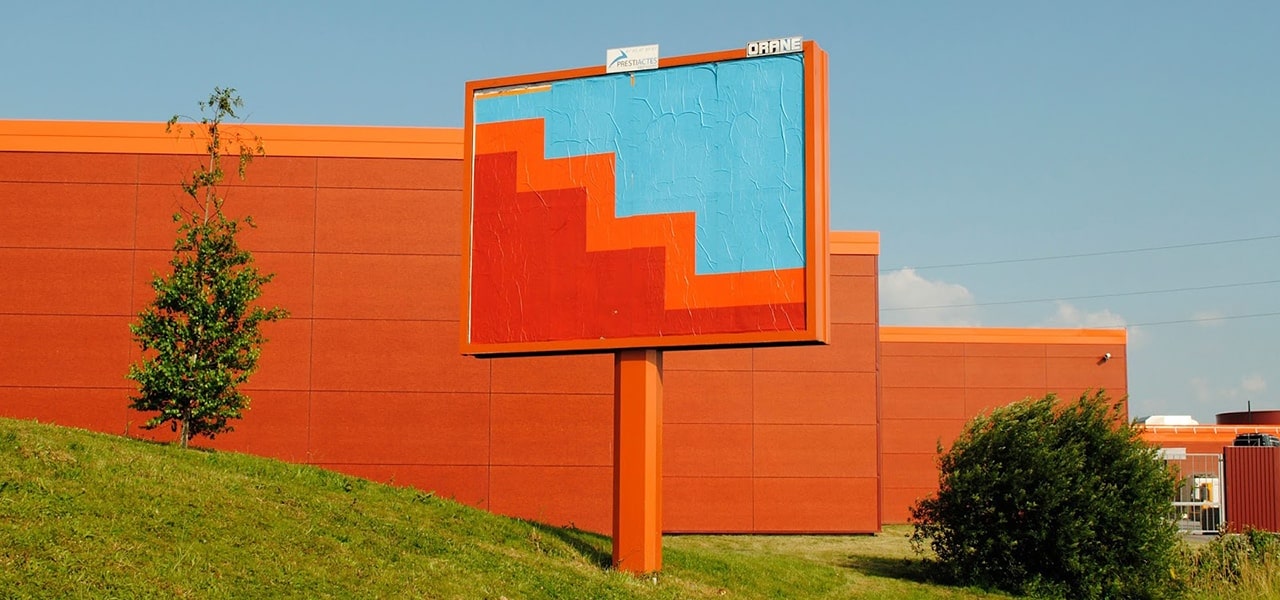
OX – Dammarie les Lys, 2013 – Image courtesy of the artist
At the Top of the Street Art World
With its roots set during the 1960s and first genuine waves appearing in the 1980s, French street art has a strong note when you look at it from a historic standpoint – it is nothing more than a logical evolution of art that plays with the idea of French identity and public spaces. Today, France is a home to exciting works by both home-grown talent and international street art superstars, as this country clearly serves a role it was granted centuries ago as it’s yet again the center towards all street art practitioners strive for. The uniqueness of French street art is not truly rivaled by any other urban stage found around the world. Whilst most other non-French pieces ask that you simply notice and acknowledge them, French street art demands that you interact with it, question it, investigate the reasons behind it, notice the environment it’s in and explore your relationship to it. This is why French scene, full of spontaneous small-scale works and specific urban installations, is considered to be the grandest of them all, as no other street art is capable of reaching that kind of level – to exist both within the identities of the past and present.
Written by Andreja Velimirović